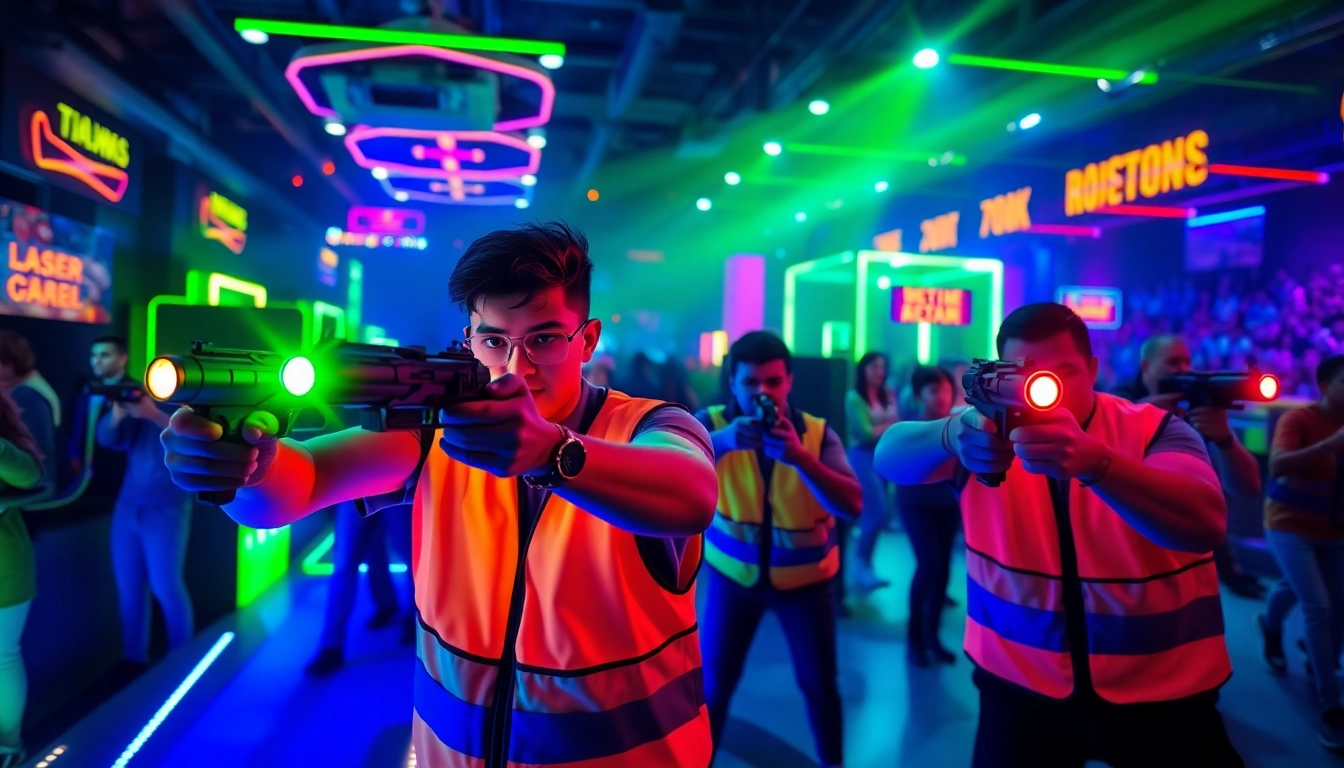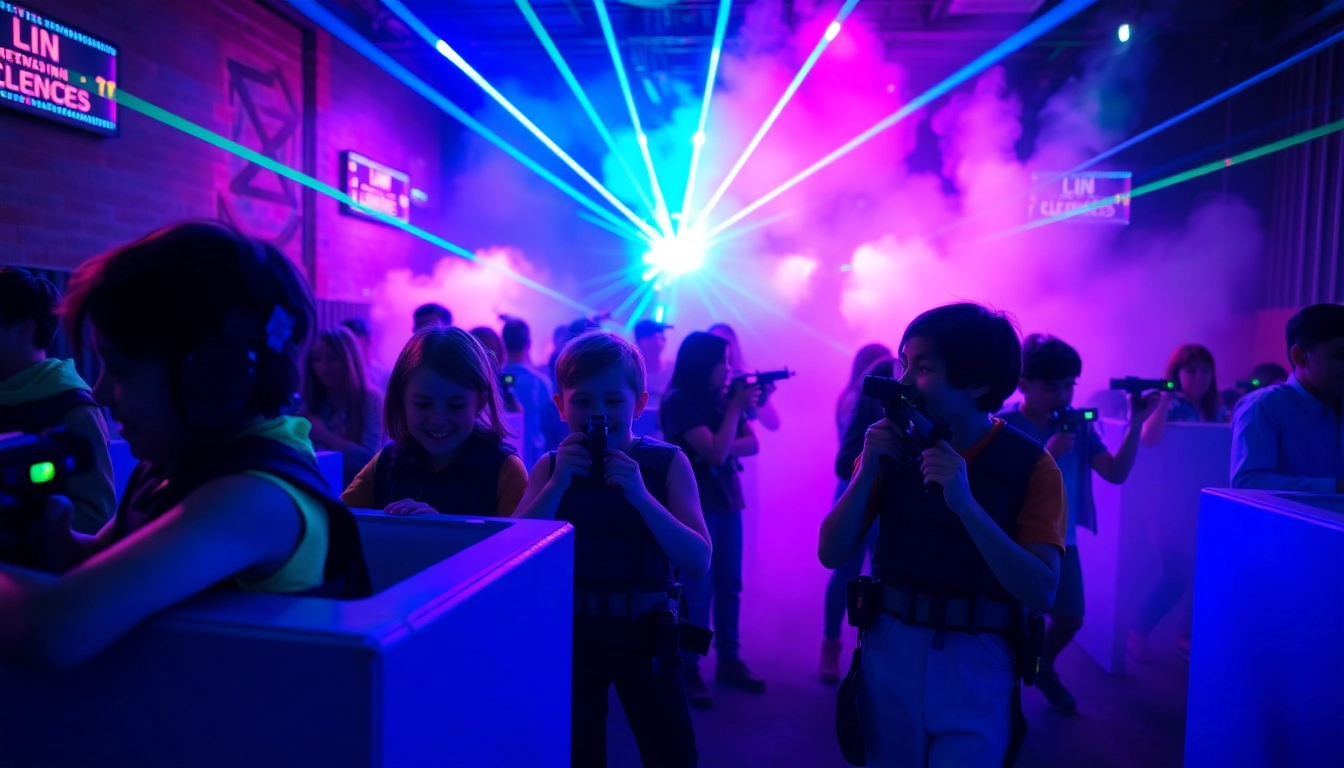Introduction to Laser Tag
In recent years, the world of recreational activities has seen a resurgence in engaging pastimes that not only entertain but also promote physical fitness and social interaction. Among these, laser tag stands out as a thrilling choice for individuals and groups alike. So, what is laser tag, and why has it gained such popularity? Let’s delve into its background, mechanics, and the benefits it offers to players of all ages.
What is Laser Tag?
Laser tag is an action-packed recreational shooting sport where players use infrared-emitting light guns to tag opponents in a designated arena. The essence of the game lies in teamwork, strategy, and reflexes as players navigate through different terrains, whether it be in a gymnasium, an outdoor setting, or a themed arena. Participants don equipment, which typically includes vests that register hits, making it a safe alternate to paintball or real-life combat simulations.
Brief History of Laser Tag
The origins of laser tag can be traced back to the late 1970s, inspired by ideas of futuristic combat and advanced multiplayer gaming. The first commercial laser tag games emerged in the early 1980s, with pioneering companies creating intricate arena layouts and high-tech equipment. Over the decades, the game evolved, benefiting from advances in technology, which led to innovations in equipment design and game mechanics. From its early days as a children’s pastime, laser tag has morphed into a versatile entertainment option suitable for various age groups and occasions.
The Evolution of Laser Tag Equipment
Modern laser tag equipment is far more advanced than its predecessors. Originally, players utilized cumbersome and less efficiently designed gear. Today’s versions are lightweight, ergonomically designed, and loaded with features such as variable weapon settings, tactical vests with built-in sensors, and advanced scoring systems. Innovations like night vision capabilities and sound effects have further elevated the immersive experience of laser tag, attracting enthusiasts from diverse backgrounds.
Benefits of Playing Laser Tag
Physical and Mental Benefits
Engaging in laser tag offers visible physical benefits, including improved cardiovascular health, increased stamina, and enhanced agility. Players must quickly navigate through obstacles, duck, run, and strategize while remaining alert, which challenges the body and mind alike. Mentally, laser tag fosters critical thinking and decision-making skills as players must adapt their strategies on the fly—making quick judgments about positioning, alliances, and game tactics.
Social Interaction and Team Building
At its core, laser tag is a team-oriented activity. It promotes cooperation and communication, essential elements for success in group play. Players develop camaraderie, resolve conflicts, and learn to trust one another. Such experiences are invaluable in both personal and professional contexts, as they help foster essential teamwork skills that can be applied in real-world situations. Additionally, participating in laser tag creates lasting memories, strengthening social bonds and enhancing interpersonal relationships.
Incorporating Laser Tag into Parties and Events
Laser tag is an increasingly popular choice for parties, corporate events, and team-building exercises. It serves as an exciting centerpiece for celebrations, bringing participants together in a fun, competitive environment. Organizers can tailor experiences to suit diverse needs—whether it’s a birthday party for kids or a corporate outing to promote team synergy. Hosting a laser tag event requires minimal planning; many venues provide equipment, setup, and even catering options, making it an attractive option for busy organizers.
Choosing the Right Laser Tag Venue
Factors to Consider in Your Selection
Selecting the right venue for your laser tag experience can greatly influence the quality of the game. Here are some factors to consider:
- Location: Accessibility and proximity are crucial. Choose a venue close to your participants to minimize travel time.
- Arena Size: A larger arena allows for diverse gameplay, enabling players to implement various strategies.
- Equipment Quality: Research the technology used by the venue. High-quality equipment leads to a more enjoyable and immersive experience.
- Game Variety: Look for venues offering multiple game formats. Different styles can keep the experience fresh and exciting.
- Safety Measures: Ensure the venue has protocols in place regarding equipment safety and general player conduct.
Indoor vs. Outdoor Laser Tag Experiences
Both indoor and outdoor laser tag provide unique advantages. Indoor arenas often feature complex layouts with obstacles, enhancing the tactical elements of the game. They also allow for consistent play in various weather conditions. Outdoor laser tag, on the other hand, can offer larger playing fields and dynamic environments that mimic real-world combat scenarios. However, each comes with its challenges, such as navigation in the dark for indoor arenas or managing weather elements in outdoor games.
Safety Measures in Laser Tag Arenas
Safety is paramount in any competitive activity. A good laser tag arena should implement strict safety measures, including:
- Regular equipment checks to ensure proper functioning of sensors and weapons.
- Clear rules regarding player conduct and engagement to prevent injuries.
- Trained staff to oversee games and promptly address any safety concerns.
- Emergency protocols in place to handle accidents or equipment malfunction smoothly.
Laser Tag Game Strategies
Basic Strategies for Beginners
New players should focus on understanding the game dynamics before diving into complex strategies. Here are some essential tips:
- Familiarize yourself with the arena layout to navigate efficiently.
- Stick with teammates to maximize your collective firepower and strategy.
- Utilize cover effectively to protect yourself while aiming to tag opponents.
- Communicate with team members about positions and strategies during the game.
Advanced Tactics for Competitive Play
As players gain experience, they may want to adopt more sophisticated strategies. High-level tactics include:
- Flanking opponents by splitting your team to cover multiple angles of attack.
- Using feints and distractions to lure opponents into vulnerable positions.
- Timing your movements with team coordination for an effective assault.
- Trapping opponents by limiting their escape routes, forcing them to make mistakes.
Communication and Team Coordination
Effective communication is the backbone of any successful laser tag team. Teams must establish clear signals and roles before gameplay to maximize efficiency. Strategies can improve drastically when every member understands both their role and the team’s overall game plan. Utilize call signs, hand signals, or specific movements to convey information without being overly loud during play. The combination of these elements will enhance overall team performance.
Future of Laser Tag
Innovations in Equipment and Gameplay
The future of laser tag is bright, driven forward by technological advancements and design innovations. Expect to see more sophisticated equipment that integrates augmented reality and interactive gaming elements, fostering immersive experiences. Wireless technology could improve connectivity, allowing multiple players to engage seamlessly across different platforms, including mobile and home systems that simulate local games.
The Growing Popularity of Laser Tag
The appeal of laser tag is expanding across the globe, resonating with a diverse audience that includes families, tourists, corporate teams, and school groups. It offers an interactive alternative to digital entertainment that promotes physical activity and social interaction, catering to the health-conscious trends growing in popularity. Communities are increasingly recognizing laser tag as a viable option for recreational facilities and entertainment centers.
Potential Trends to Watch
As laser tag moves forward, several key trends can be anticipated:
- Integration with Virtual Reality: Merging laser tag with VR technology can amplify immersion, providing unique game experiences.
- Customized Experiences: Expect more venues to offer tailored gameplay options based on players’ preferences, skill levels, and even themed events.
- Health and Fitness Focus: As wellness becomes a priority, venues may promote laser tag as not only fun but a fitness-friendly activity that encourages movement.



